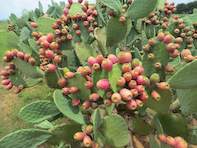Cactus pear originated in the Central Mexican Valley, being cultivated in Mesoamerica since the Aztec times. Christopher Columbus is thought to have taken the succulents to Spain, as a sample of the exotic flora of the new world, and the leaves were used as a vegetable on Spanish ships since the 1700s.

While the Aztecs cultivated the species as food, feed and for medicinal purposes, early European interest was driven by the demand for the intense red dye, called carminic acid, produced by cochineal insects living on the plants. By the end of the 16th century, carminic acid was the most desired commodity from America, surpassed only by precious metals.
Today, cactus pear is considered one of the most commercially important cactus species in the world, with the term “cactus pear” generally reserved for the spineless types that are cultivated, and “prickly pear” reserved for the spiny, wild-growing weedy types.
Dr Herman Fouche of the Animal Production Institute of the Agricultural Research Centre (ARC) explains that the cactus pear types have short hair-like thorns, called glochids, whereas prickly pear types have longer thorns.
Cactus pear types, in effect, may be kept in check through the grazing of animals, whereas the thorns on the prickly pear types protect them from grazing. They, in effect, often form impenetrable thickets, which is why they are considered invasive in many parts of the world.
In South Africa, specifically, prickly pear has been declared a category 1 weed, so may not be traded and should be destroyed as far as possible. Cactus pear trading and production are allowed, but growers should carefully manage production as the prickly types may emerge from the cultivated types through cross pollination.
While the fruit is delicious, it does not taste like a pear, neither does it have the same shape or texture.
Drought Tolerance
Cactus pears are found across the world, particularly in Mediterranean or sub-tropical climates. The plants are remarkable because of their ability to grow under arid conditions that would be too harsh for most other plants to survive.
They have shallow roots that are increased through the formation of secondary nodes during rainy seasons and contracted at the start of dry seasons. The stems or leaves, called cladodes, also have the ability to store considerable amounts of water.
Besides this, water loss through evaporation is reduced by the leaves being protected by a wax layer and the plants having few stomas per surface area that, unlike most other plants, only open at night. Their survival rate is further increased by the fact that they are able to reproduce without seeds.
International Production
Mexico is considered the biggest international producer, with most of the South American countries, such as Chile, Brazil and Argentina, producing large volumes. Italy is the biggest producer in Europe and Morocco in Africa.
Cactus Pear Uses
Cactus pears are incredibly versatile, with the whole plant being suited for usage. The fruit is fat free and rich in vitamins, minerals, fibre and antioxidants. The fruit can be enjoyed fresh and in salads, but also be made into juice, jam, jelly, chutney and preserved like gherkins as well as used for alcohol production to make beer, wine, mampoer and liqueurs.
While South Africans are familiar with the fruit, the Mexicans have long been preparing dishes from the young leaves, called Nopalitos, which is rich in protein, minerals and vitamins, especially vitamin A and C. In Mexico, the vegetables are cooked, tinned and also milled to produce flour for baking.
Besides this, the plants can be used as animal fodder and to make silage. Read more about this in Cactus Pear as Livestock Feed. It also has medicinal, cosmetic and industrial applications, and can be used to produce biogas for electricity production.
Cactus Pear Eating Tips
Depending on the cultivar, the Cactus pear should be slightly coloured when ready to eat, but not overly so. The fruit should not look dehydrated, carry any mould or have any signs of decay.
The Cactus pear can be stored at room temperature for up to two weeks and unpeeled cactus can be stored in the fridge for several weeks without losing flavour. The fruit bruises easily so should be handled with care.
Use a knife and a fork to avoid contact with the peel. The Cactus Pear Growers Association of South Africa advises consumers to hold the fruit steady with the fork and to then cut off the ends of the fruit with the knife. Next, a vertical slice should be made through the fruit’s skin and the skin then be cut away from the fruit. The fruit can then be rolled out of the opened skin.
Read more about Cactus Pear Production in South Africa.